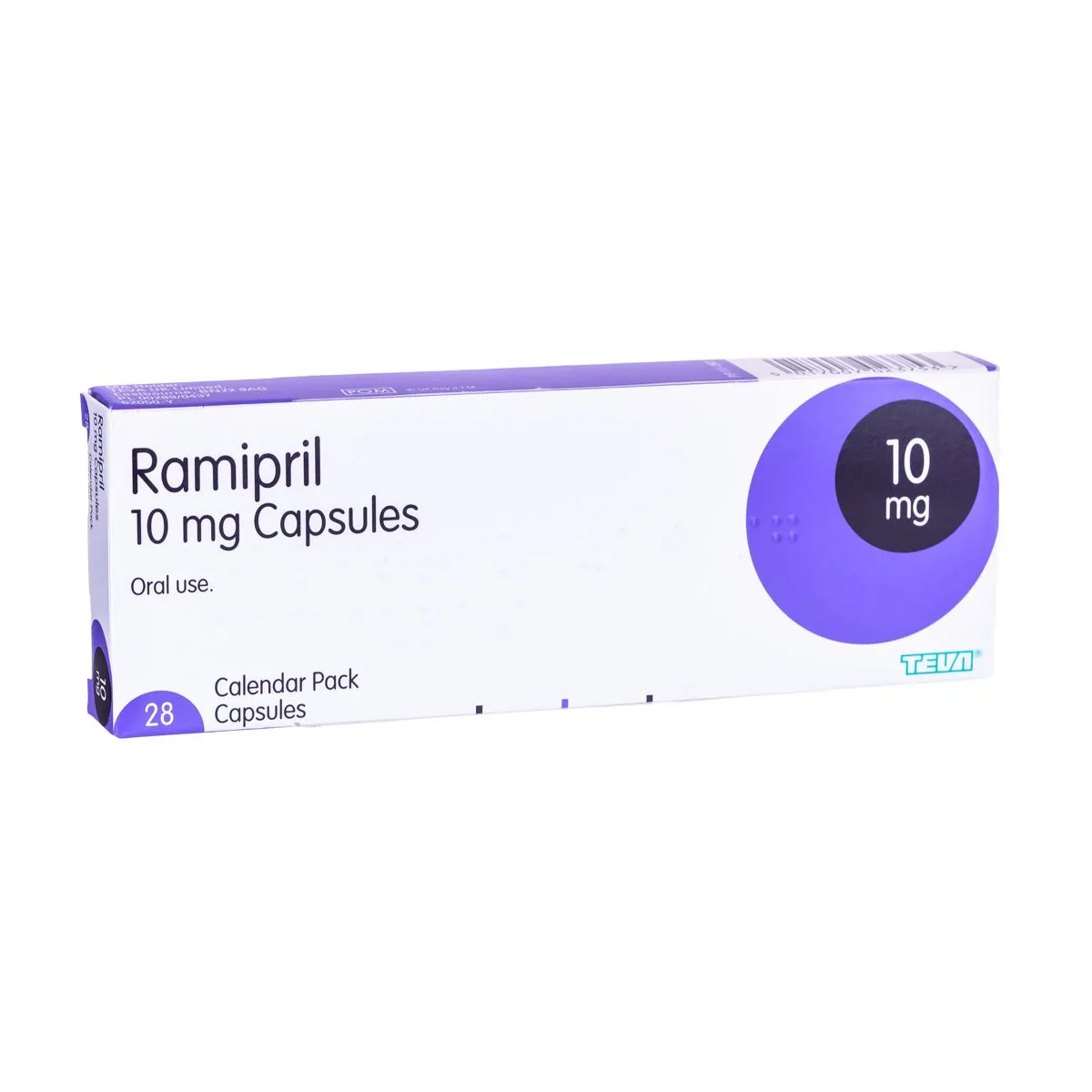Description
Ingredients
The active ingredient in Ramipril is Ramipril.
Inactive ingredients may include:
- Lactose monohydrate
- Starch
- Magnesium stearate
- Microcrystalline cellulose
Always refer to the patient information leaflet for a full list of ingredients, as they may vary depending on the brand or formulation.
Side Effects
Common side effects of Ramipril may include:
- Headache
- Dizziness
- Fatigue
- Nausea
- Cough
- Rash
Serious side effects can occur, though they are rare. These include:
- The swelling of the face, lips, tongue, or throat is known as angioedema.
- Severe allergic reactions can cause breathing difficulties and chest tightness.
- Low blood pressure can cause symptoms such as dizziness and fainting.
- High potassium levels can cause symptoms such as irregular heartbeat and muscle weakness.
- Kidney problems (reduced urination, swelling, and fatigue)
If you experience any of these serious side effects, seek medical help immediately.
Warnings
- Allergic reactions: Ramipril can cause severe allergic reactions, including angioedema, which can be life-threatening. If you develop swelling of the face, lips, throat, or tongue, stop taking Ramipril and seek emergency medical attention.
- Kidney issues: Ramipril can affect kidney function, particularly in patients with pre-existing kidney problems. Your doctor will monitor kidney function during treatment.
- Pregnancy: Avoid using ramipril during pregnancy, particularly in the second and third trimesters, as it may harm the developing baby. We will recommend alternative medications if you are pregnant or planning to become pregnant.
- Breastfeeding: Ramipril passes into breast milk, and it is generally advised to avoid breastfeeding while taking this medication.
- Low blood pressure: Ramipril may cause a sudden drop in blood pressure, particularly after the first dose. Your doctor may recommend starting with a low dose.
- Electrolyte imbalances: Ramipril can cause imbalances in potassium and sodium levels. Regular blood tests may be required to monitor these levels during treatment.
How to Take
- Dosage: The typical starting dose for adults is 2.5mg to 5mg once daily, which can be gradually increased depending on your response. For hypertension, doses may range from 2.5mg to 10mg daily. Doctors may prescribe higher doses for heart failure or post-heart attack treatment.
- Administration: Take Ramipril orally, with or without food. Swallow the tablet whole with a glass of water.
- Missed dose: If you forget to take a dose, take it as soon as you remember, unless it’s almost time for your next dose. In that case, skip the missed dose and resume your regular schedule. Never take two doses to make up for a missed one.
- Long-term use: People often take ramipril to manage high blood pressure or heart failure over an extended period. It’s important to continue taking it as prescribed, even if you feel well, to maintain heart health and reduce the risk of complications.
FAQs About Ramipril
How long does Ramipril take to work?
After taking the first dose, ramipril can start lowering blood pressure within a few hours, but it may take several weeks to feel its full effects. For heart failure, it may take longer to notice improvements.
Can I drink alcohol while taking Ramipril?
Alcohol can increase the risk of low blood pressure and dizziness when combined with Ramipril. It’s advisable to limit alcohol consumption while on this medication.
What should I do if I experience a persistent dry cough?
A dry cough is a known side effect of ACE inhibitors like Ramipril. If the cough is bothersome, consult your doctor. If the cough persists, your doctor may recommend an alternative medication.
Can I take Ramipril with other medications?
Ramipril may interact with other medications, including diuretics, potassium supplements, NSAIDs (non-steroidal anti-inflammatory drugs), and lithium. Always inform your doctor of any other medications you are taking, including over-the-counter drugs and supplements.
Is Ramipril safe for people with kidney problems?
If you have pre-existing kidney issues, Ramipril may affect kidney function. Your doctor will monitor your kidney health through regular blood tests and adjust your treatment if necessary.
Is it possible to abruptly stop taking Ramipril?
Do not stop taking Ramipril suddenly without consulting your doctor, as this may cause your blood pressure to rise rapidly. Your doctor will advise you on the proper way to discontinue the medication if needed.
What if I feel light-headed after taking Ramipril?
Some people may experience dizziness or light-headedness, especially after the first dose. If you feel faint or light-headed, sit or lie down until the feeling passes. Avoid driving or operating heavy machinery if you’re feeling unsteady.
Can I take Ramipril while pregnant or breastfeeding?
Ramipril is not recommended during pregnancy, particularly in the second and third trimesters, as it may harm the baby. If you’re pregnant or planning to become pregnant, speak to your doctor for alternative treatment options. Additionally, we do not recommend Ramipril during breastfeeding.
Does Ramipril cause weight gain?
Weight gain is not a common side effect of Ramipril. However, it’s crucial to discuss any unexpected weight changes with your doctor as they might indicate other underlying health issues.
How often will I need to see my doctor while taking Ramipril?
Regular check-ups are important to monitor your blood pressure, kidney function, and electrolyte levels while taking Ramipril. Your doctor will schedule follow-up appointments and blood tests as needed to ensure the medication is working effectively and safely.
Always follow your doctor’s instructions when taking Ramipril and discuss any concerns or side effects with them to ensure the best outcomes for your health.





Reviews
There are no reviews yet.